You are in the right place if you are looking for the best abs exercises and workouts that you can do at the gym to build six-pack abs and strong core muscles.
Anyone can achieve a toned and chiseled six-pack with the right abs workouts.
We will take you through the most effective ab exercises that will target all areas of your core, from weighted crunches to planks and leg raises to cable twists.
We’ve got 20 ways to make your abs routine more effective with the equipment at your gym, such as a pull-up bar, cable machine, abs roller, and a dumbbell.
We will also give you expert advice on form, frequency, and the best routine to get the most out of your workout.
Next time you’re at the gym, pick three of the moves below and stick to them. We promise you’ll feel the burn and see results.
Want To Build Six Pack ABS: Use Our Free Calculator To Know Your Fat Loss Calories Requirement
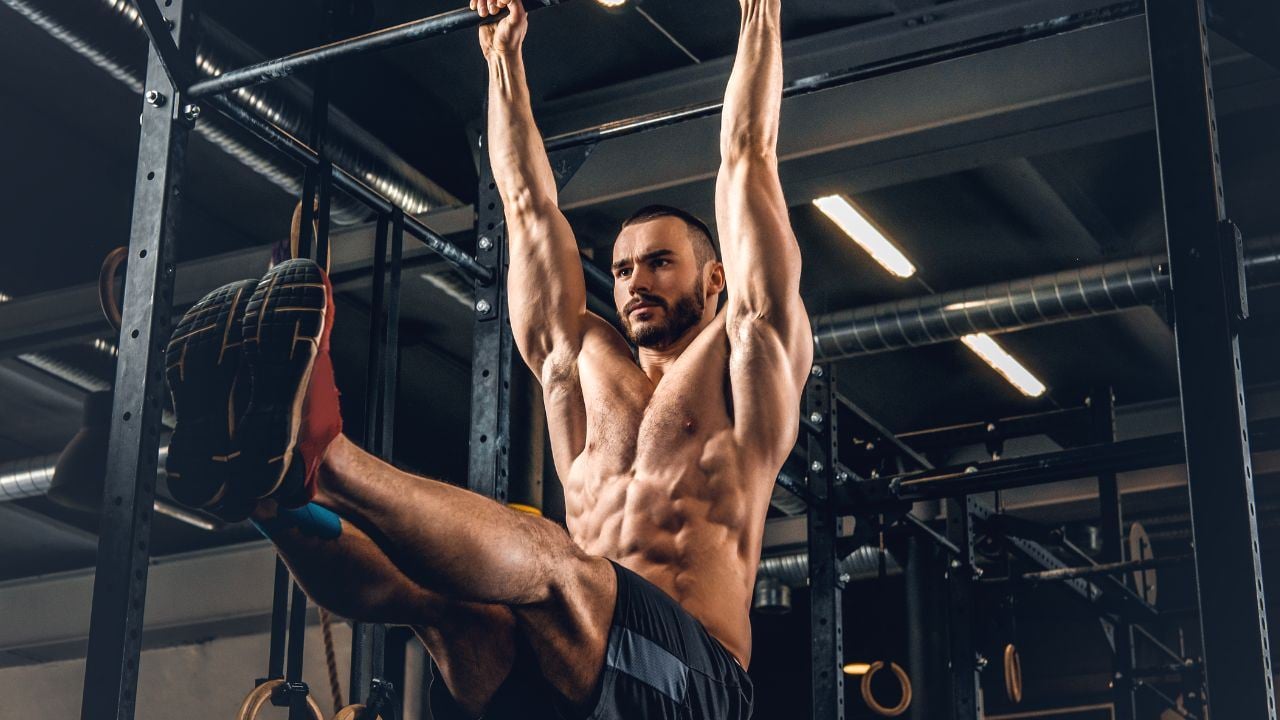
- 20 Best Gym Abs Workouts for a Stronger Core
- 1. Cable Crunch
- 2. Machine Crunch
- 3. Landmine Twists
- 4. Cable Side Bend
- 5. Hanging Knee Raise
- 6. Hanging Straight Leg Raise
- 7. Hanging Windshield Wiper
- 8. Abs Wheel Rollout
- 9. Barbell Rollout
- 10. Pallof Press
- 11. Cable Wood Chop
- 12. Cable down-up twist (Reverse Woodchop)
- 13. Cable Twist
- 14. Stability Ball Tuck
- 15. Incline Reverse Crunch
- 16. Twisting Sit-Up
- 17. Weighted Front Plank
- 18. Side Plank Lateral Raise
- 19. Standing Machine Twist
- 20. Dumbbell Wood Chop
- How To Train Complete Abs With Gym Equipment
- Upper Abs Workout In Gym
- Lower Abs Workout In Gym
- Oblique Workout At Gym
- How To Incorporate Ab Workouts Into Gym Routine?
- Gym Abs Workout Routine Using Gym Equipment
- Abs Workout Plan
- Oblique Workout Plan
- The Anatomy of Your Abs
- Rectus Abdominis
- External and Internal Obliques
- Transverse Abdominis
- Core
- FAQ
- What gym workout is best for abs?
- What can I do at the gym for abs?
- Is it worth training abs in the gym?
- How often should I train my abs at the gym?
- How do I get a six-pack at the gym?
- Can I train my abs every day at the gym?
- Should I focus more on high reps or heavy weights for ab workouts?
- Takeaways
20 Best Gym Abs Workouts for a Stronger Core
Here are the best abs exercises at the gym to add to your workout to build a strong core and six-pack abs.
1. Cable Crunch
Cable crunches, also known as kneeling cable crunches, are a weighted Crunch variation that targets your ab and core muscles. Perform cable crunch at the gym by kneeling in front of a cable station with a pulley attachment.
Doing Abs crunches exercises on a cable apparatus at a gym offers one huge advantage over doing them on the floor.
The cable increases resistance, enabling you to train to failure using heavier weights and fewer reps—this increased emphasis on strength and hypertrophy.

How To Do Cable Crunch
- Kneel in front of a high pulley.
- Grasp the rope attachment in each hand and place your wrists against the sides of your head.
- Lower your torso by flexing your hips, but allow the rope’s weight to lift your upper torso to extend your lower back.
- Keeping your hips fixed, exhale as you pull the rope downward by flexing your abdomen so that your back becomes arched.
- Hold for a count of two. Relax your abdomen and allow the rope to lift your upper torso so that your lower back goes back to being extended.
Tips
- Keep your neck in a neutral position.
- Keep your hips fixed. All the movement should be in your abdomen.
- Don’t choose a heavy weight that your lower back handles most of the resistance.
2. Machine Crunch
An excellent way to strengthen your abdominal muscles is to use an abs crunch machine. Undoubtedly, adding this movement to your gym workout regime will help you get great abs.
This is a convenient way to add resistance to your abdominal exercises for better abs and core development.

How To Do Machine Crunch
- Sit on the ab machine and select a slight resistance.
- Position your feet under the pads and hold the handles at the top.
- Make sure your arms are bent at 90 degrees.
- Keep your feet stationary and perform crunches as instructed in the machine directions.
- Pause and slowly return to the starting position as you inhale.
Tips
- Use a slow, controlled motion to target the muscles.
- Keep your motions slow and steady to reduce the risk of injury.
- Do not overload the machine. Go with the weights that you have worked with before and eventually build up.
3. Landmine Twists
The landmine twist exercise is one of the best abs exercises to add to your gym workout regime.
The landmine twist is a rotational abdominal movement performed using an angled barbell anchored at floor level in a landmine device.
It targets the deep muscles of the core, including both the obliques and the transversus abdominis.

How To Do Landmine Twists
- Position a bar into a landmine or securely anchor it in a corner. Load the bar to an appropriate weight.
- Raise the bar off the floor, taking it to shoulder height with both hands with your arms extended in front of you.
- Rotate the trunk and hips as you swing the weight all the way down to one side.
- Keep your arms extended throughout the exercise.
- Reverse the motion to swing the weight all the way to the opposite side.
Tips
- Keep a slight bend in your knees as you rotate. This should help remove tension from your lumbar spine during the movement.
- Try to keep your arms straight.
4. Cable Side Bend
The cable side bend is a core-strengthening exercise specifically targeting the obliques. This exercise also improves stability in the lower back and hips.
Cable side bends are more controllable; you can achieve more with less weight, allowing you to stay within an active range of motion for your obliques.
I usually do 15-20 reps on each side in a controlled manner to train my oblique effectively. You should also try this with light weights.

How To Do Cable Side Bend
- Attached D-handle to a low pulley and stood side-on to the weight stack.
- Grasp the D-handle with your right hand and stand with the pulley to your right side.
- Your torso should be laterally flexed (bent sideways) towards the pulley.
- Your arm should be straight and close to your body.
- Bend your torso away from the pulley, pulling the D-handle upward.
- Slowly lower the D-handle back to the starting position by bending your torso towards the pulley.
- Repeat for the desired number of repetitions.
- Turn around and repeat the cable side bend with your left side.
Tips
- Keep your arm close to your body and your hips still throughout the exercise.
- Perform this exercise slowly and steadily to work the obliques.
5. Hanging Knee Raise
The hanging knee raise is one of the best abs exercises that people do at the gym for building strength in the hip flexors and developing the six-pack and stronger core.
It enhances basic strength and hypertrophy of core muscles, assisting in movements like squats, cleans and snatches, bracing, and more.
It is one of my favorite abdominal exercises that I use to train and build strong core muscles after a leg workout.

How To Do Hanging Knee Raise
- Grab a bar with an overhead grip, with the hands slightly wider than shoulder-width and your knees slightly bent.
- Keep your core and glutes tight to keep your back and hips in the correct position.
- Lift your legs and bend your knees on the way up to pull your knees toward your chest.
- Pause in this position for a second, and slowly lower your legs back down to the start position.
Tips
- Try not to use momentum to raise your legs. Keep the movement slow and under control.
- To make it more difficult, straighten your legs (hanging straight leg raise), or hold a dumbbell between your feet.
- Remember to engage your core before you raise your knees
- Keep your back straight to avoid putting too much pressure on your spine.
6. Hanging Straight Leg Raise
A hanging leg raise is an exercise that primarily works the abs and hip flexors and is a great addition to any fitness routine for overall core strength, spine health, and mobility.
In fact, studies have shown that hanging leg raises activated the rectus abdominis by 100% and activated the oblique muscles by 88%.
Hang on a pull-up bar and lift your legs; in turn, your abs tighten and strengthen.

How To Do Hanging Straight Leg Raise
- Grab a bar with an overhead grip, with the hands slightly wider than shoulder-width.
- Keep your core and glutes tight to keep your back and hips in the correct position.
- Keeping your legs straight, lift both legs toward your chest, using your hips and ab muscles. Exhale as you lift your legs up.
- Slowly lower your legs back down to the start position without swinging, inhaling as you go down.
Tips
- If you’re a beginner, do the bent knee variation and gradually straighten your legs as you get better at this exercise.
- Please do this in a controlled motion while lifting your legs until they are at a 90-degree angle.
- Pull your legs up as high as you can above your waistline for a harder variation.
7. Hanging Windshield Wiper
The hanging windshield wiper is one of the more advanced gym exercises that help strengthen your abdominal muscles.
It gets its name from the posture adopted, resembling a car’s window wipers, as an individual performs each rep.
The goal is to rotate the torso from one side to the other whilst maintaining a horizontal position.

How To Do Hanging Windshield Wiper
- Grab a bar with an overhead grip, with the hands slightly wider than shoulder-width.
- Keep your core and glutes tight to keep your back and hips in the correct position.
- Lift your legs towards the bar. Keep your arms and legs straight. Your legs are perpendicular to your torso.
- Now, rotate your legs to one side until they are parallel with the floor, roughly 90 degrees.
- Slowly and with control, rotate your legs to the other side. Keep your legs as straight as possible.
Tips
- Do not lower your legs beyond feeling a mild stretch in your side.
- You can make the move easier by bending your knees.
- Don’t use momentum to aid you; use your core strength.
Know More: 100+ Ways To Lose Weight (Proven Techniques)
8. Abs Wheel Rollout
The wheel roll is a great exercise for exercising your Abs at the gym. This is one of my favorite exercises.
What makes the ab wheel so effective? It leverages the concept of eccentric strength-building flawlessly. To build yourself up to it, you can start with the plank and graduate to the wheel rollout when ready.
As you roll out, your core muscles are worked hard, and your abs are stretched to keep a neutral spine position without falling over.
Its design and mechanics give the abs a unique challenge that traditional exercises may not be able to match. They’re also an excellent conditioning exercise for athletes.

How To Do Abs Wheel Rollout
- Kneel on the floor and grasp the ab wheel roller with your hands.
- Your arms should be straight and your torso fairly upright in the start position.
- Allow the abs wheel to roll forward as far as possible, with only your knees and toes touching the floor.
- In the finish position, your torso and upper legs should be parallel to the floor, hovering just a couple of inches above it.
- Then, reverse the motion to pull the abs wheel back toward your knees until your body is upright again.
Tips
- Squeeze your abs and glutes throughout the movement for stability.
- Move within a comfortable range of motion. You should not strain your lower back.
- Do not allow your hips to sag at any point during the movement.
9. Barbell Rollout
The barbell roll-out is an advanced gym exercise that uses a barbell to train the abs muscles.
Many lifters may not be able to perform a single rep at first, but once they can perform these for reps, they’ll be rewarded with a seriously strong core.
I enjoy this exercise because I feel that my abs are completely trained after doing it.

How To Do Barbell Rollout
- Kneel on the floor in front of a loaded barbell and grab the barbell with an overhand, shoulder-width group.
- Your arms should be straight and your torso fairly upright in the start position.
- Let the bar roll forward as far as possible without touching the ground.
- In the finish position, your torso and upper legs should parallel the floor.
- Then, reverse the motion to pull the bar back toward your knees until your body is upright again.
Tips
- Squeeze your abs and glutes throughout the movement for stability.
- Move within a comfortable range of motion. You should not strain your lower back.
- Do not allow your hips to sag at any point during the movement.
10. Pallof Press
If you’re looking for a way to get more creative with your abs exercises at the gym, why not try Pallof Press?
It is a full-body exercise that can increase overall stability and activate many large muscle groups in the body.
The Pallof Press is an anti-rotation hold exercise that will work wonders in helping you develop a stable core. It is a valuable movement prep and core strengthening exercise for nearly every lifter.
It helps to establish proper spinal alignment under load and increase core stability.

How To Do Pallof Press
- Attach a handle to a chest-high cable pulley.
- Stand on the side of the cable machine with your feet hip-width apart.
- Grasp the handle with the hand nearest the pulley, pull the handle to your chest, and place your free hand over the hand holding the handle.
- Engage your core and press the handle out with both hands, so your arms are extended in front of your chest.
- Hold this position for five to ten seconds and then bring the handle back to your chest.
- Repeat the exercise on your opposite side.
Tips
- Maintain a forward chest and straight back throughout the entire exercise.
- Use a challenging weight, but only to where you can maintain a straight body position.
11. Cable Wood Chop
The cable woodchop is great for strengthening the twisting movement pattern of your torso, as well as improving your torso’s ability to resist twisting forces.
It is a compound pulling motion and a functional exercise, primarily targeting the abdominal and obliques. It also employs the shoulders, back, and glutes.
You can do wood chops with a dumbbell or medicine, but the cable will give a preferable constant tension. It is one of my favorite exercises that I include during my core-strengthening workout.

How To Do Cable Woodchop
- Attach a handle to the top of the cable pulley.
- Grasp the handle with both hands, with either your fingers interlaced or with one hand over the other.
- Stand next to the machine with your feet shoulder-width apart.
- Keep your arms straight and pull the handle diagonally upward until your torso faces away from the pulley and your hands are knee height.
- Hold for a count of two. Then, slowly reverse the movement to return to the starting position.
- Repeat the exercise on your opposite side.
Tips
- Don’t lock the knees and hips. Allow the hips and knees to rotate slightly.
- Keep your arms straight and shoulders locked in place.
12. Cable down-up twist (Reverse Woodchop)
The cable down-up twist mimics many activities and sports movements that require rotational strength, such as swinging a golf club or throwing a ball.
Use the cable down-up twist to strengthen and stabilize your core and strengthen your torso’s rotational movement pattern.

How To Do Reverse Wood Chop
- Attach a handle to the lowest of the cable pulley.
- Grasp the handle with both hands, with either your fingers interlaced or with one hand over the other.
- Stand next to the machine with your feet shoulder-width apart.
- Pull the handle upwards until your body is away from the pulley.
- Hold for a count of two. Then, slowly reverse the movement to return to the starting position.
- Repeat the exercise on your opposite side.
Tips
- Don’t lock the knees and hips. Allow the hips and knees to rotate slightly.
13. Cable Twist
The cable twist is an isolation exercise that works the oblique muscles of the side abs.
It’s unique in that it not only helps to strengthen the core muscles, but it’s a functional exercise because it’s performed on the feet.
Use the cable twist to strengthen your body’s twisting movement pattern.

How To Do Cable Twist
- Attach a handle to a shoulder-height cable pulley.
- Attach a D-handle or rope attachment to the cable machine at shoulder height.
- Stand sideways to the machine with your feet shoulder-width apart.
- Hold the handle or rope with both hands in front of your chest.
- Grasp the handle with both hands, with either your fingers interlaced or with one hand over the other.
- Pull the handle across your body until your torso is away from the pulley.
- Hold for a count of two. Then, slowly reverse the movement to return to the starting position.
- Do 10–15 repetitions on each side for 2–3 sets.
Tips
- Try to keep the rotation of your hips to a minimum and focus on the twisting movement of your torso.
- Keep your chest lifted and core engaged for optimal stability.
14. Stability Ball Tuck
Stability Ball Tuck, also known as Stability-Ball Jackknife, is a core stabilizing exercise that improves balance, strength, and flexibility throughout the hip and abdominal region.
It is one of those abdominal exercises that looks like fun to do, but it is very effective.
It targets the major muscle groups of the core while also targeting the stabilizing muscles of the chest, shoulders, and hips.

How To Do Stability Ball Tuck
- Lie on the floor in a push-up position with your feet resting on top of an exercise ball.
- Tuck your knees in toward your chest while rolling the ball forward.
- Hold the tucked position for a second, then return to the starting position by extending your legs.
- Repeat for the desired number of reps.
Tips
- Keep your neck neutral.
- Do not allow your hips to sag throughout the movement.
15. Incline Reverse Crunch
The incline reverse crunch is similar to the traditional reverse crunch, except that it is performed on an incline bench or slant board.
Since it requires you to work against gravity, it puts more tension on the abs and is more difficult than the standard version.
This exercise strengthens the hip flexors and lower abs region, as well as improving stability and mobility throughout the lower back.
Placing your torso on an incline increases the range of motion and places more tension on your abs, which makes the exercises more difficult.

How To Do Incline Reverse Crunch
- Lie on an incline bench, with your head where your feet normally go.
- Hold on to the leg pads to hold your torso in place on the bench.
- Bend your hips and knees to 90-degree angles for the start position of the reverse crunch.
- Maintain the bend in your knees and hips, and flex your spine from the bottom to lift your hips up off the bench and curl your knees toward your head.
- Slowly reverse the motion to return your legs to the start position.
- Repeat for the desired number of repetitions.
Tips
- Keep the movement slow and controlled. Do not use momentum.
- Increase the incline by raising the bench to add more resistance.
- Hold a small dumbbell between your legs for additional resistance.
16. Twisting Sit-Up
A decline sit-up bench positions your upper body at an angle so that it’s lower than your hips and thighs.
This positioning causes your body to work harder, since you must work against gravity and through a wider range of motion.
It’s a great exercise for intermediate to advanced lifters because it is moderately challenging but very effective for its intended purpose.

How To Do Twisting Sit-Up
- Sit on the decline bench, hook your feet under the pad, lean back, and position your hands behind your head.
- As you sit up, twist your torso, directing your right elbow toward your left knee.
- Do the opposite of what you did before and lower your body back to where you started.
- When you do the next one, use your left elbow to reach your right knee.
- Keep repeating and alternating the side to which you twist your waist.
Tips
- Keep your neck in a neutral position.
- Use a slow, controlled motion to target the muscles.
17. Weighted Front Plank
If you feel prepared to increase the intensity of your plank exercises, you can add a weighted plank to your workout routine. I usually use a weighted plank to train the core muscles during my ab workout.
Weighted planks work better than bodyweight ones and will help you build a strong core, strengthen your abdominal muscles, and show six-pack abs.
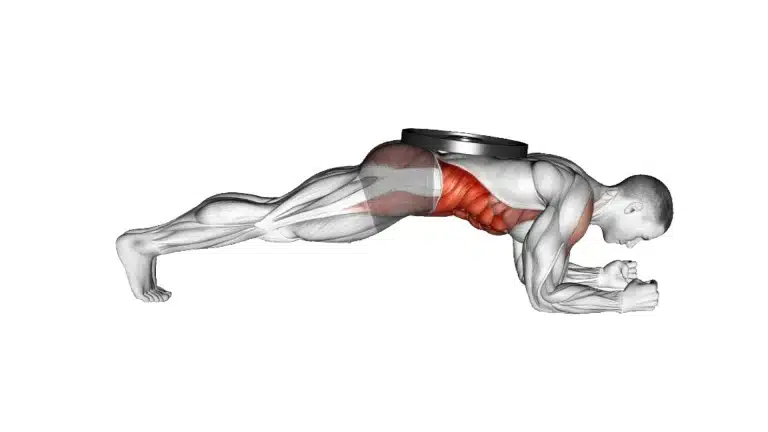
How To Do Weighted Front Plank
- Start in a front plank.
- Your body should form a straight line from your shoulders to your ankles. Tighten your stomach muscles.
- Have your spotter place a weight plate on your back.
- Hold the front plank position with the weight plate on your back.
- Hold this position for a set amount of time.
- Have your spotter take the weight plate off your back.
18. Side Plank Lateral Raise
The side plank lateral raise is an exercise that combines an isometric plank hold with a dumbbell side raise to target both the core and the shoulders.
For this movement, you may not be able to use much weight without disrupting your balance, but even at lightweight, it is a movement that can help address multiple muscle groups in a time-efficient workout.
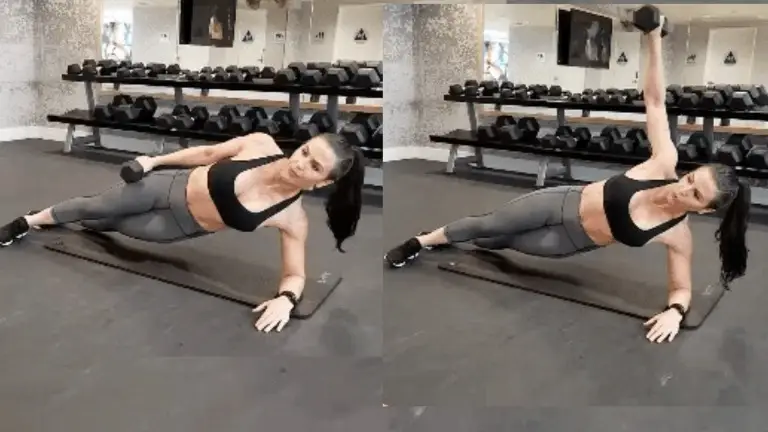
How To Do Side Plank Lateral Raise
- Get in a side plank position by lying on your left side on the floor.
- Hold a dumbbell in your top hand, with your arm resting along the side of your body.
- Slowly raise the weight, making sure not to extend beyond your shoulder.
- Slowly lower your arm back down. Complete the desired number of repeats.
- Repeat the movement on your right side.
19. Standing Machine Twist
You can easily do this standing machine twist in the twisting machine.
The standing machine oblique twist challenges your core stability as you resist the rotational force generated by the machine.
It strengthens your abs and oblique muscles, which may help you avoid back injuries.
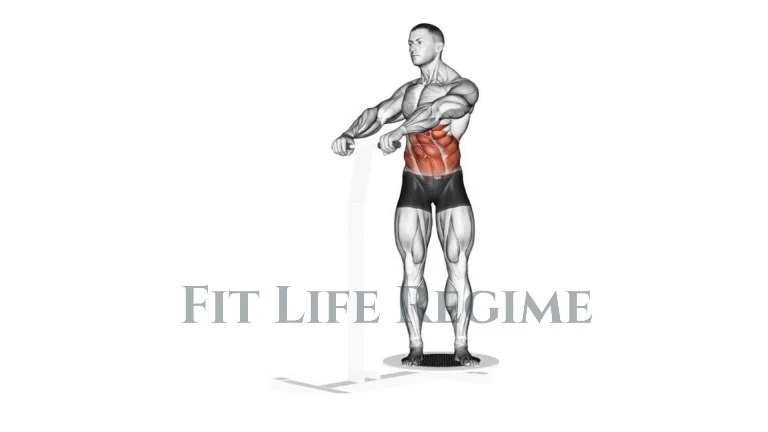
How To Do Standing Machine Oblique Twist
- Stand on a twisting machine with feet and hips apart and hold the machine handles.
- Assume a normal posture, with your back straight.
- Exhale and, using your abdominal muscles, twist the pelvis slowly to your right, as far as you can, tensing your abs.
- Hold the stretch for several seconds and return to your starting position while inhaling.
- Perform the stretch on the other side, this time turning to your left as far as you can without moving your head and upper torso.
Tips
- Keep your head and upper torso in their starting position – immobile.
20. Dumbbell Wood Chop
The Dumbbell wood chop is also known as the dumbbell up-down twist; you must add these oblique workouts to your dumbbell abs workout arsenal.
This is great for strengthening the twisting movement pattern of your torso, as well as improving your torso’s ability to resist twisting forces.
The dumbbell wood chop is a compound pulling motion and a functional exercise. While it primarily targets the abdominal and obliques, it also employs the shoulders, back, and glutes.
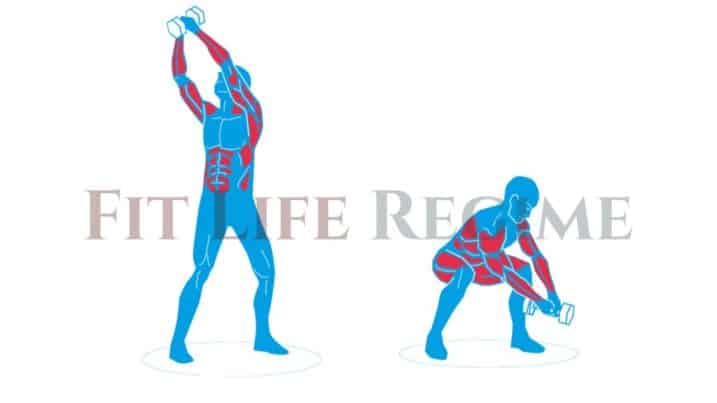
How To Do Wood Choppers with Dumbbell
- Hold the dumbbell with both hands, with either your fingers interlaced or with one hand over the other.
- Keeping your arms straight, rotate the dumbbell diagonally downward until your torso rotates to the opposite side and your hands are at knee height.
- Hold for a count of two. Then, slowly reverse the movement to return to the starting position.
- Repeat the exercise on your opposite side.
- Do 3–4 sets of 10–15 reps a side.
Tips
- Don’t lock the knees and hips. Allow the hips and knees to rotate slightly.
- Control the weight the whole time.
How To Train Complete Abs With Gym Equipment
Do you want to lose that belly fat and finally achieve a rock-hard abs? Then, you must try these abs exercises during your next gym workout.
Training your abs at the gym requires a comprehensive approach targeting the different areas of your abdominal muscles from various angles.
Target, hitting the different areas of your abs from every angle. Some exercises concentrate on your upper abs, some focus on the lower abs, and some work the often neglected side abs – or obliques – along with your deeper core muscles.
You can get a well-rounded and defined midsection with exercises that work the upper abs, lower abs, obliques, and deeper core muscles.
BODY FAT % CALCULATOR: KNOW YOUR BODY FAT PERCENTAGE TO GET VISIBLE ABS
Upper Abs Workout In Gym
The rectus abdominis’ main jobs are flexion of the torso, which means forward bending (bringing your chest toward your hips), and flexion of the hips. It essentially means bringing your pelvic bone/hips upward.
Your upper abs will be the most activated during movements that bring your upper body toward your hips/legs (spinal flexion).
For example, the following gym exercises will target your upper abs:
- Cable Crunches
- Twisting Sit-Up
- Vertical Leg Crunch
Lower Abs Workout In Gym
When it comes to targeting the lower abs in the gym, it’s important to focus on exercises that bring your thighs toward your chest.
You can effectively isolate and strengthen the lower abdominal muscles through these specific movements.
Here are some exercises that are known to work the lower abs.
- Hanging leg raises,
- Reverse crunches and
- Stability ball Tuck,
- Mountain Climbers
- Captain’s Chair Leg Raises
Oblique Workout At Gym
The obliques work together to help you bend side-to-side, rotate your torso from left to right, and assist with spinal flexion.
For example, the following gym exercises will target your oblique:
- Cable Side Bend
- Landmine Twists
- Cable Wood Chopper
- Side Plank
Know More: Best Abs Exercises: Upper Abs, Lower Abs, Obliques
How To Incorporate Ab Workouts Into Gym Routine?
Gym machine workouts help strengthen your core more dynamically.
Machines like the cable setup, and the pull-up bar allow you to work your abs for improved muscular endurance.
They also help burn abdominal fat. Other machines, such as the abs roller developer, can also increase the intensity.
All the gym machines listed below can help you strengthen your core muscles, including your rectus abdominis, obliques, and deep abdominal muscles.
- The cable machine can be used for strength, flexibility, and speed. Every cable exercise will work your core to some degree. The wood chop and the Pallof press are some of the most effective cable machine exercises to build six-pack abs.
- You could use a pull-up bar at your gym to sculpt your abs with exercises like hanging leg raises and hanging windshield wipers. You work your abdominal muscles whenever you hang from the bar and brace your core.
- When you do sit-ups and reverse crunch on a decline bench, you increase the amount of gravity you bring into the equation. It works your muscles differently, intensifies your sit-ups and reverse crunch.
Gym Abs Workout Routine Using Gym Equipment
The abs need to be trained with adequate volume and frequency and with considered exercise selection and progressive overload, just like any other muscle group.
You could train abs twice weekly, one session using an abs exercise and the other using an oblique exercise, and achieve adequate volume throughout the whole area.
You could use them as a finisher, picking two or three moves and cycling between them with minimal rest in between, or you could separately train your core.
Below are some sample workout plans to train your core, abs, and obliques separately with gym equipment.
Abs Workout Plan
| Exercises | Sets | Reps |
|---|---|---|
| Cable Crunch | 3 | 10-15 |
| Landmine Twists | 3-4 | 12-15 |
| Hanging Knee Raise | 3 | 8-12 |
| Abs Wheel Rollout | 3 | 8-12 |
Oblique Workout Plan
| Exercises | Sets | Reps |
|---|---|---|
| Cable Side Bend | 3 | 10-15 |
| Pallof Press: | 3-4 | 6-8 |
| Cable Wood Chop | 4 | 8-12 |
| Landmine Twists | 3 | 10-15 |
Of course, you don’t have to do gym exercises for your ab workouts.
In fact, you probably should mix it up with:
- Bodyweight Abs Exercises You Can Do At Home Without Equipment
- Abs & Oblique Cable Exercises & Workout
- Best Dumbbell Abs Workout To Build Six Pack Abs
If you want a well-rounded abs and oblique and core workout, then you must add variation to your workout.
We strongly suggest adding Planks and leg raises to your routine once you have achieved sufficient core strength to perform them safely and correctly.
The Anatomy of Your Abs
Your waist comprises two muscle groups: the rectus abdominis (known as your “six-pack” muscles) In the front and the obliques on each side.
To build the impressive six-pack abs, first, we needed to understand the anatomy and functionality of the abs.
It helps you do the abs exercises on the gym machine at the best level.
Rectus Abdominis
The rectus abdominis is a paired muscle running vertically down the front of the abdomen. It is commonly referred to as the “six-pack” muscle.
The two rectus abdominis muscles (one on each side) are encased in a sheath of fascia that forms the central dividing line down the middle of the abs.
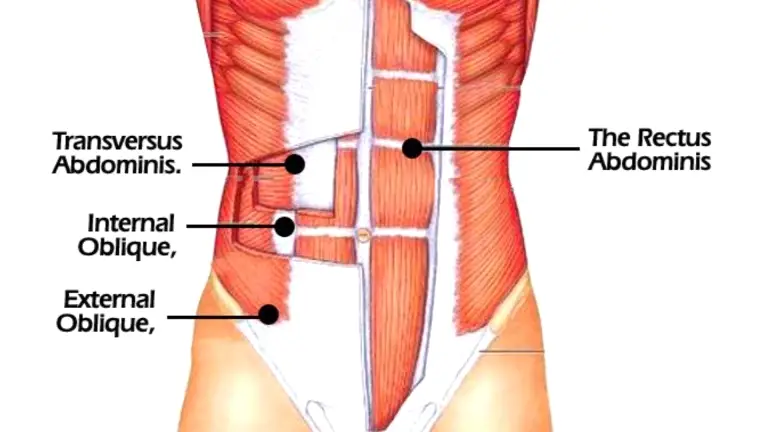
External and Internal Obliques
They are located on the sides of the abdomen.
- The external oblique is the outer visible layer that passes run diagonally on each side of the rectus abdominis.
- The internal oblique muscles lie under the external obliques and run into the lower back.
- The oblique muscles play a crucial role in torso rotation and lateral flexion, aiding in activities like twisting and bending sideways.
Transverse Abdominis
The transverse abdominis is the deepest layer of the abdominal muscles, running horizontally across the abdomen.
It acts as a natural corset, providing stability and support to the spine.
Core
The core comprises the abdominal muscles and the muscles of the lower back, hips, and pelvis. They work together to stabilize and support the spine.
The abdominal muscles work in synergy with other core muscles to provide stability, transfer force, and maintain proper posture.
FAQ
What gym workout is best for abs?
If you hit the gym, the above-mentioned abs machine exercises are a great way to start building six-pack abs.
What can I do at the gym for abs?
For doing the abs workout at the gym choice, do 3-4 exercises mentioned above and do 3-4 sets. If you’re incorporating heavy weight with some moves, do lower reps.
It is advisable to modify the workout according to intensity and duration.
Is it worth training abs in the gym?
Training abs with weight at the gym helps to build strong abs muscles and can help improve posture and balance. They can also help reduce back pain and increase flexibility.
How often should I train my abs at the gym?
It is recommended to train your abs 2-3 times per week. It’s also important to rest and recover after exercise to avoid overworking yourself.
How do I get a six-pack at the gym?
Doing cable crunches and other targeted gym exercises is great for toning abdominal muscles, but the first step towards revealing your abs is losing both subcutaneous and visceral fat.
When there is fat under the skin, it will prevent you from seeing your abdominal muscles.
You need to remove subcutaneous fat from your abdominal area to have defined abs or a six-pack.
Can I train my abs every day at the gym?
You shouldn’t train your abs daily because they need time to recover and repair. Overtraining your abs can lead to muscle fatigue and hinder progress. Allow at least two days of rest between ab workouts.
Should I focus more on high reps or heavy weights for ab workouts?
For ab workouts, focusing on high reps rather than heavy weights is generally more effective.
The abdominal muscles are primarily endurance muscles, so performing exercises with higher repetitions can help improve tone and definition.
Takeaways
A wide variety of gym abs exercises will help you achieve your six-pack abs goal. You can do the same using different gym equipment like cables, barbells, and machines.
Thanks for reading; enjoy your Workout!
Stay Fit, Live a Happy and Healthy Life
Reference
- Hsu SL, Oda H, Shirahata S, Watanabe M, Sasaki M. Effects of core strength training on core stability. J Phys Ther Sci. 2018 Aug;30(8):1014-1018. doi: 10.1589/jpts.30.1014. Epub 2018 Jul 24. PMID: 30154592; PMCID: PMC6110226.
- Vispute SS, Smith JD, LeCheminant JD, Hurley KS. The effect of abdominal exercise on abdominal fat. J Strength Cond Res. 2011 Sep;25(9):2559-64. doi: 10.1519/JSC.0b013e3181fb4a46. PMID: 21804427.
- Norris CM. Abdominal muscle training in sport. Br J Sports Med. 1993 Mar;27(1):19-27. doi: 10.1136/bjsm.27.1.19. PMID: 8457806; PMCID: PMC1332101.
- Oliva-Lozano JM, Muyor JM. Core Muscle Activity During Physical Fitness Exercises: A Systematic Review. Int J Environ Res Public Health. 2020 Jun 16;17(12):4306. doi: 10.3390/ijerph17124306. PMID: 32560185; PMCID: PMC7345922.
- Yoo WG. Effect of modified leg-raising exercise on the pain and pelvic angle of a patient with back pain and excessive lordosis. J Phys Ther Sci. 2017 Jul;29(7):1281-1282. doi: 10.1589/jpts.29.1281. Epub 2017 Jul 15. PMID: 28744065; PMCID: PMC5509609.

Manish is a NASM-certified fitness and nutrition coach with over 10 years of experience in weight lifting and fat loss fitness coaching. He specializes in gym-based training and has a lot of knowledge about exercise, lifting technique, biomechanics, and more.
Through “Fit Life Regime,” he generously shares the insights he’s gained over a decade in the field. His goal is to equip others with the knowledge to start their own fitness journey.

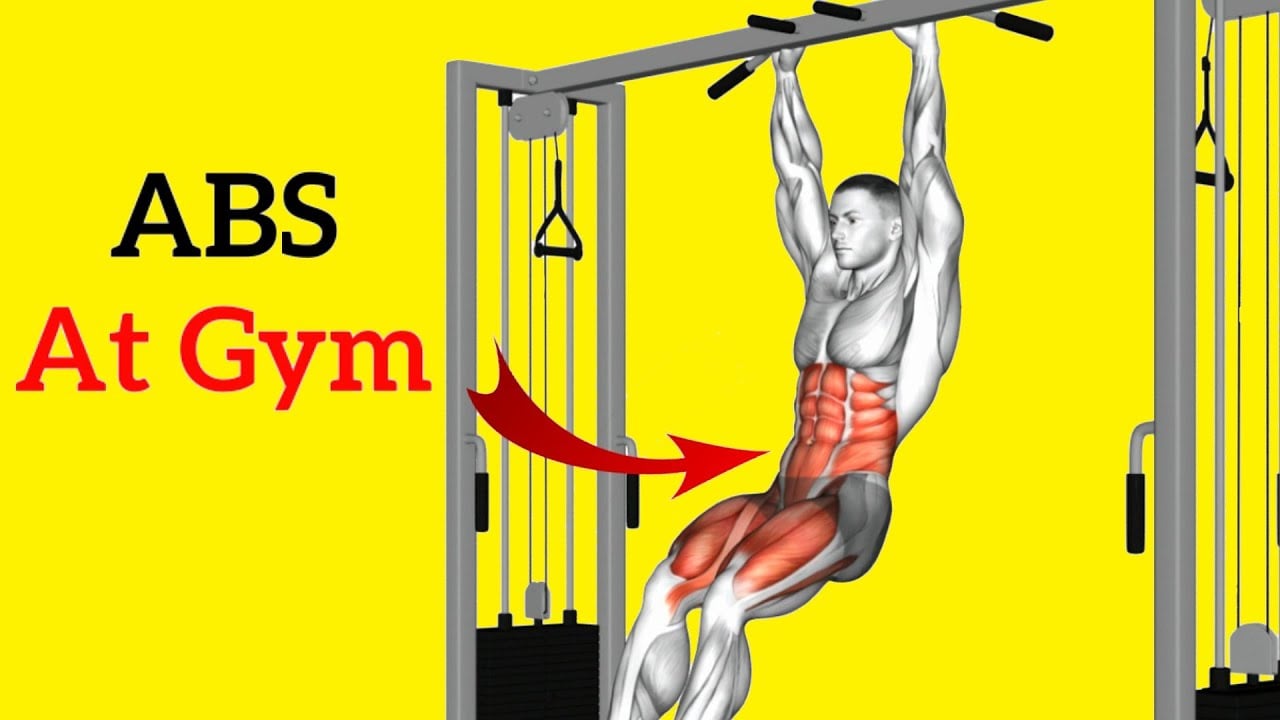
Hello
I was googling for content about Ab exercises When I came across your excellent resource page.
I just wanted to say that your page helped me, I would have never found the resource without it.
Here it is in case you’d like to check it out https://www.elnodiacademy.com/abs-exercises-gym
Also, my guide might make a nice addition to your page.
Either way, thanks for putting together your list of resources. And have a great day.